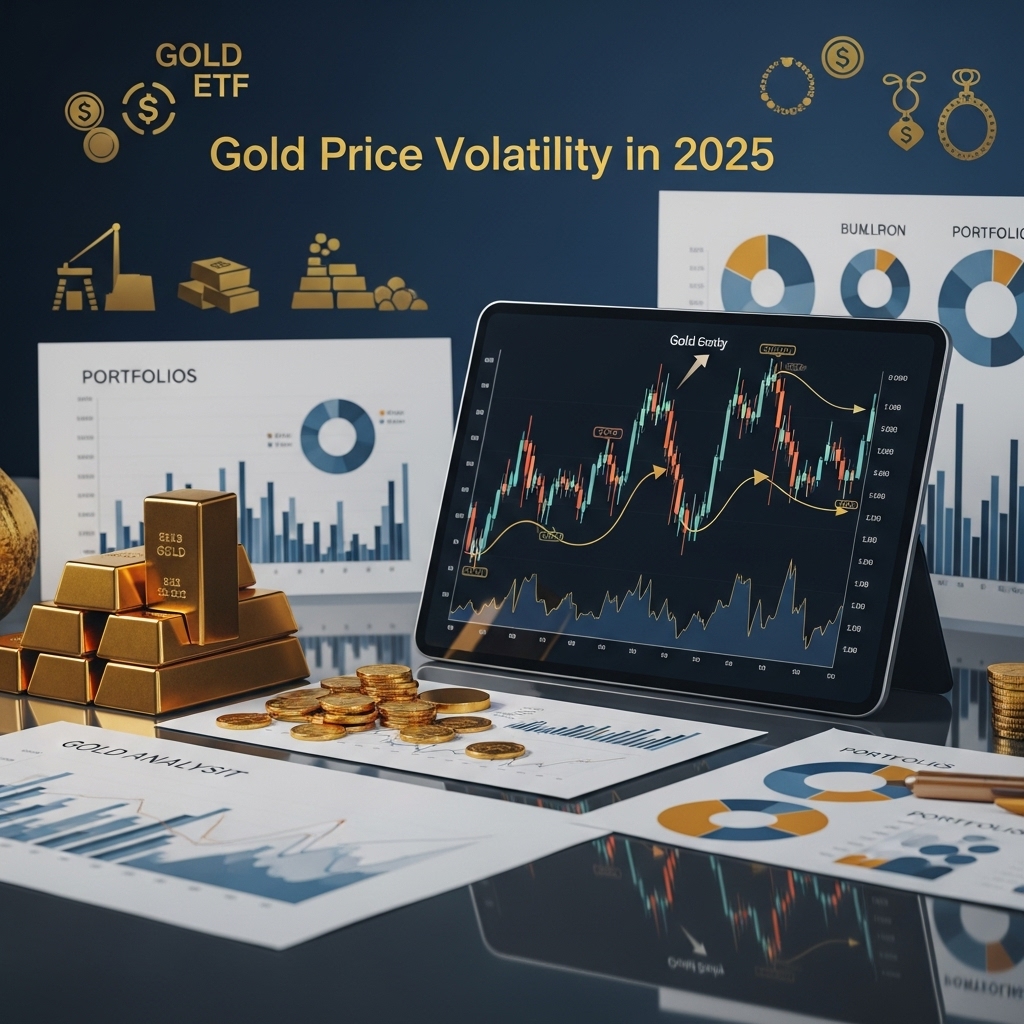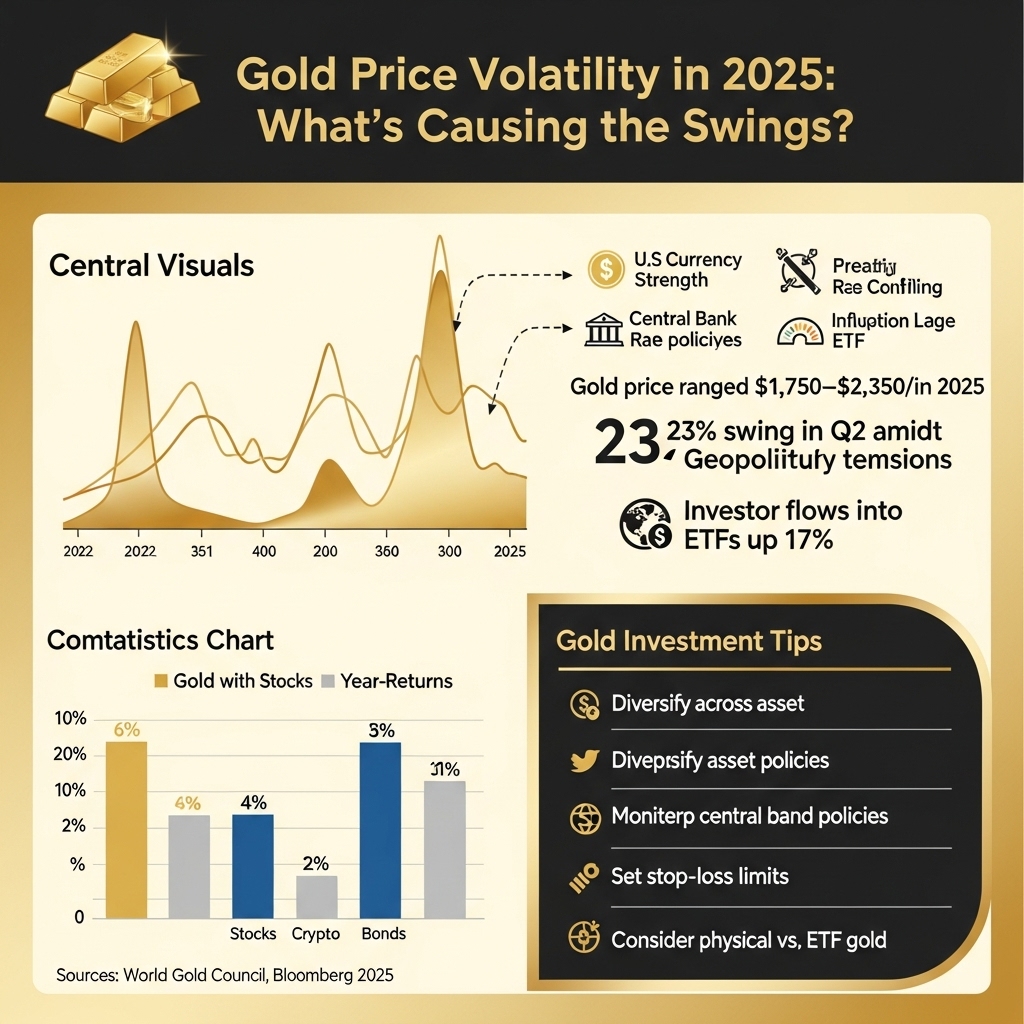Gold Price Volatility in 2025: What’s Causing the Swings?
As 2025 unfolds, gold investors have found themselves glued to the charts, watching the precious metal’s price ricochet with a breathtaking intensity. Just when it seemed that gold had struck a steady upward path, sudden drops and rapid rebounds have become the new normal. Behind these dramatic moves lie a complex web of global forces, making gold’s recent volatility both concerning and intriguing for anyone looking to safeguard or grow their wealth.
In this post, we’ll unpack the main drivers fueling gold’s price swings in 2025, ranging from shifting central bank policies and geopolitical tensions to surging retail and institutional demand. We’ll explore how inflation rates, currency fluctuations, and market sentiment are shaping trends unlike any other period in recent history. For new and seasoned investors alike, understanding the reasons behind these movements isn’t just about curiosity—it’s vital for making informed decisions, capitalizing on opportunities, and managing risks within your portfolio.
With gold’s enduring reputation as a hedge against uncertainty, these unpredictable market dynamics carry significant implications. Whether you’re considering your first purchase or reviewing your long-term holdings, knowing what’s moving the gold market in 2025 can be the key to unlocking both protection and profit in the year ahead.
Gold Market Analysis and Key Insights
Dynamics Behind Recent Gold Price Fluctuations
In 2025, the gold market has continued its streak of heightened volatility, registering price swings between $2,000 and $2,350 per ounce from January to June. The driving forces behind this volatility include persistent geopolitical tensions, notably in Eastern Europe and the Middle East, and divergent central bank policies. Heightened uncertainty has positioned gold as an appealing safe-haven asset, causing sharp price surges during periods of escalated conflict or financial instability. Additionally, central banks—particularly in emerging markets—have bolstered their gold reserves, further affecting liquidity and price trends.
Current Trends and Market Data
Recent data from the World Gold Council indicates that demand for physical gold, especially from sovereign banks and retail investors, remains robust. Exchange-traded funds (ETFs) backed by physical gold saw net inflows of over 5%, reversing outflows observed in 2023. Meanwhile, gold mining output has plateaued, as new projects face regulatory and environmental hurdles, keeping supply relatively tight. The U.S. dollar’s moderate fluctuations and anticipation of future rate cuts by the Federal Reserve have also contributed to short-term price swings.
Investment Benefits and Considerations
Gold’s resilience amidst macroeconomic uncertainty reaffirms its reputation as a hedge against inflation and currency depreciation. For diversified portfolios, gold offers a low correlation to equities and bonds, enhancing overall risk management. However, investors must consider volatility risk, potential premiums on physical gold, and liquidity constraints for certain gold products. Additionally, short-term speculation can increase price instability, reinforcing the importance of a long-term perspective.
Expert Recommendations
Analysts recommend that investors maintain a balanced approach, allocating 5–10% of their portfolios to gold and gold-related assets. Long-term holders should prioritize exposure through low-cost ETFs or reputable bullion providers, with periodic portfolio rebalancing. Experts caution against overexposure, emphasizing gold’s role as a stabilizer rather than a primary growth engine. In the current climate, strategic gold investment provides both diversification and downside protection amid ongoing market swings.

Gold Investment Strategies and Options
In the context of heightened gold price volatility in 2025, investors must thoughtfully evaluate their approach to gold investment. There are several ways to invest in gold, each with unique advantages and risks:
Physical Gold
Investing directly in bullion, coins, or jewelry provides tangible ownership and insulation from financial system risks. However, storage, insurance, and low liquidity are potential drawbacks. This method suits long-term, conservative investors or those seeking a hedge against geopolitical or currency risks.
Gold Exchange-Traded Funds (ETFs) and Mutual Funds
Gold ETFs and funds offer exposure to gold prices without the hassle of physical storage. These vehicles are liquid, accessible, and cost-effective, appealing to investors who value convenience and flexibility. Still, they carry counterparty and market risks, and some may prefer direct ownership of gold.
Gold Mining Stocks and Funds
Investing in mining companies provides leveraged exposure to gold prices. When prices rise, mining stocks often outperform physical gold, though they also bear additional risks—operational, geopolitical, and management-specific factors can impact returns. Diversified mining funds can help spread these risks.
Futures and Options
For sophisticated investors, gold futures and options allow tactical allocation and speculation on price swings. While they offer significant profit potential, leverage increases risk, making these best suited for experienced traders.
Risk Assessment and Portfolio Allocation
Given gold’s volatility, prudent allocation is essential. Most experts recommend holding 5–10% of a diversified portfolio in gold as a hedge against inflation and market shocks. Overexposure can heighten portfolio risk and reduce long-term returns.
Comparison and Market Timing
Physical gold offers the most security, while ETFs and mining stocks provide liquidity and growth potential. Achieving optimal results may mean blending multiple strategies. While timing gold purchases amid volatility is tempting, dollar-cost averaging can help mitigate the risks of short-term price swings and emotional decision-making.
Ultimately, aligning gold investment choices with risk tolerance, time horizon, and financial goals is essential to navigate the volatility expected in 2025.
Market Performance and Outlook
Gold prices have historically displayed both periods of stability and pronounced volatility. Over the past decade, gold generally trended upwards, notably peaking above $2,060 per ounce in 2020 as a safe haven during pandemic uncertainty. Throughout 2023, the metal fluctuated within a range of $1,800–$2,050/oz, driven by inflation fears and shifting monetary policy. In 2025, gold’s price volatility has intensified, with swings between $2,000 and $2,200/oz in early quarters, reflecting heightened geopolitical risks and concerns over global economic growth.
Current market conditions suggest a fragile equilibrium. Central banks continue robust gold purchases as part of reserve diversification, while investors respond to signals on US interest rates, inflation readings, and persistent tensions in Eastern Europe and the Middle East. Meanwhile, physical gold demand from China and India remains strong, buffering prices during sell-offs.
Looking ahead, analysts predict continued volatility for the remainder of 2025. Much will depend on the trajectory of interest rates, especially from the US Federal Reserve. A dovish turn could propel gold higher, whereas persistent rate hikes may cool its momentum. Inflation trends, dollar strength, and ongoing geopolitical uncertainties are expected to keep investors hedged with gold. Additionally, economic factors such as recession concerns, shifts in currency values, and global debt levels will remain central drivers. Overall, while swings are likely to persist, the long-term outlook for gold remains cautiously optimistic.
Frequently Asked Questions About Gold Investment
What factors are causing gold price volatility in 2025?
Gold price swings in 2025 are mainly driven by global inflation, changing interest rates, geopolitical tensions, and shifts in central bank policies. Uncertainties in major economies, ongoing conflicts, and currency fluctuations also significantly impact prices.
How do interest rates affect gold prices?
Gold does not yield interest or dividends, so when interest rates rise, investors may move money to assets that do. Higher rates make gold less attractive, often causing its price to drop. Conversely, lower rates can support or lift gold prices.
Is gold still a good hedge against inflation in 2025?
Yes, gold remains a traditional hedge against inflation because its value tends to rise when the purchasing power of currency declines. However, 2025’s price volatility means investors should be prepared for short-term fluctuations even if gold helps preserve value in the long run.
What are the risks of investing in gold during turbulent markets?
Market turmoil can lead to sudden, significant gold price swings. Liquidity concerns and rapid sell-offs are possible, as well as wider bid-ask spreads. Investors should be mindful of timing and diversification to manage these risks.
Should I invest in physical gold or gold ETFs?
Both have pros and cons. Physical gold avoids some market risks but requires secure storage. Gold ETFs are convenient, liquid, and easy to trade but come with management fees and rely on the stability of financial markets. The choice depends on individual preferences and investment goals.

Final Thoughts on Gold Investment
In summary, gold price volatility in 2025 is shaped by global economic uncertainty, shifting central bank policies, fluctuating inflation, and ongoing geopolitical tensions. For investors, these market swings underscore the importance of both vigilance and strategic planning. While short-term fluctuations can seem unsettling, gold’s historical role as a safe-haven asset and portfolio diversifier remains strong. Our final recommendation: maintain a balanced approach—don’t chase the spikes, but consider allocating a portion of your portfolio to gold as a long-term hedge against uncertainty. As always, review your financial goals and consult with a trusted advisor before making major investment decisions. Ready to navigate the gold market more confidently? Subscribe to our newsletter for up-to-date insights and actionable strategies tailored for today’s dynamic environment.